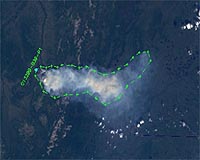| . |  |
. |
Gainesville FL (SPX) Jun 09, 2009 As the frozen soil in the Arctic thaws, bacteria will break down organic matter, releasing long-stored carbon into the warming atmosphere. At the same time, plants will proliferate, nurtured by balmier temperatures, more nutrients from decomposing soil and the increasing abundance of the greenhouse gas they depend on for growth. These connected but contrasting changes have raised a question for scientists who study the causes and consequences of global climate change: Will the shrubs and incipient forests spreading across the Arctic compensate for the permafrost's rising release of carbon, blunting its impact on a warming planet? Or, with twice as much carbon locked up in the permafrost as now present in the atmosphere, will the lush growth become overwhelmed - like a kitchen sponge put down to stem a water main break? Researchers led by a University of Florida ecologist may have an answer. In a paper set to appear May 28 in the journal Nature, the team reports experimental results suggesting tundra plant growth may keep up with rising carbon dioxide initially. But if thawing continues in a warmer world, the permafrost will spew carbon for decades, and the plants will become overwhelmed - unable to sop up the excess carbon despite even the most vigorous growth. "At first, with the plants offsetting the carbon dioxide, it will appear that everything is fine, but actually this conceals the initial destabilization of permafrost carbon," said Ted Schuur, a UF associate professor of ecology and lead author of the paper. "But it doesn't last, because there is so much carbon in the permafrost that eventually the plants can't keep up." Schuur noted most of the 13 million square kilometers, or roughly 5 million square miles, of permafrost in Alaska, Canada, Siberia and parts of Europe remain frozen. However, thawing already occurring around its southern edges is expected to expand this century. Should that occur, this study suggests the permafrost could lose in the range of 1 gigaton of carbon, or 1 billion tons, per year - about the same order of magnitude as being added by current deforestation of the tropics, another large biospheric source, Schuur said. While burning fossil fuels contributes considerably more carbon, about 8.5 gigatons annually, that process can at least in theory be controlled - whereas once the permafrost thaw begins, it sets up a self-reinforcing loop far from human activity and potentially difficult to stop. That highlights the urgent need to address human-caused emissions now, Schuur said. "It is not an option to be putting insulation on top of the tundra," he said. "If we address our own emissions, either by reducing deforestation or controlling emissions from fossil fuels, that's the key to minimizing the changes in the permafrost carbon pool." Researchers from UF used hand-built, automated chambers to trap and measure carbon dioxide losses in Alaska year-round from 2004 through 2006. Thawing at the research sites near Denali National Park, in central Alaska, varies considerably, with some plots much more extensively thawed than others. The researchers determined how long each spot had been thawing using long-term data from permafrost-monitoring instruments combined with historical aerial photographs. With a total of 18 of the automated chambers, they measured the release and uptake of carbon between the tundra and the atmosphere. This resulted in a measurement of net ecosystem carbon exchange - the total carbon each spot lost, or gained, due to thawing permafrost. The results were clear. Tundra sites that had thawed for the past 15 years gained net carbon, as increasingly verdant plant growth was greater than the permafrost's carbon losses. However, radiocarbon dating of carbon dioxide showed that old carbon from the permafrost was already being released in higher amounts due to thaw - signifying that all was not well with the permafrost carbon even in that time period. The site that began thawing decades before gained net carbon emission to the atmosphere, revealing that more thaw caused significantly more old carbon loss - despite greening of the vegetation, including more shrubs. Said Jason Vogel, a UF postdoctoral associate and author of the paper: "The plants are still growing faster in the extensively thawed area, but that's not enough to keep up with the greater microbial activity releasing old carbon from deeper in the soil." As a result, even as the Arctic greens, its escalating old carbon loss "could make permafrost a large biospheric carbon source in a warmer world," according to the paper.
Share This Article With Planet Earth
Related Links University of Florida Beyond the Ice Age
 Spring Agricultural Fires Have Large Impact On Melting Arctic
Spring Agricultural Fires Have Large Impact On Melting ArcticDurham NH (SPX) Jun 08, 2009 Scientists from around the world will convene at the University of New Hampshire to discuss key findings from the most ambitious effort ever undertaken to measure "short-lived" airborne pollutants in the Arctic and determine how they contribute in the near term to the dramatic changes underway in the vast, climate-sensitive region. The two-year international field campaign known as POLARCA ... read more |
|
| The content herein, unless otherwise known to be public domain, are Copyright 1995-2009 - SpaceDaily. AFP and UPI Wire Stories are copyright Agence France-Presse and United Press International. ESA Portal Reports are copyright European Space Agency. All NASA sourced material is public domain. Additional copyrights may apply in whole or part to other bona fide parties. Advertising does not imply endorsement,agreement or approval of any opinions, statements or information provided by SpaceDaily on any Web page published or hosted by SpaceDaily. Privacy Statement |